

A tiny state in the north of India, Sikkim was an independent Buddhist kingdom until 1973 when it was annexed by India following the war between China and India. Sikkim is made up of mostly Nepali and indigenous Lepcha tribe people. It is treated well by the Indian government, who pours in tons of money to encourage tourism, low-land Indians to move north and mix into the indigenous population, and keep Sikkimese content with Indian governance. The state borders China (Ex-Tibet), Nepal, and Bhutan and is a state of steep lush green hills and deep valleys of rushing glacial rivers culminating in the massive Himalayas along the north and western borders. Tibetan Buddhism flourishes in this fog shrouded cloud forest and this time of year, one has to be lucky and up at sunrise to catch any views of the high peaks. But we were adamant to catch a glimpse of the 3rd highest mountain in the world, Kanchenjanga.

India, despite encouraging tourism to Sikkim

sure has a lot of red tape involved in trying to do any hiking in the wilderness. There were 3 layers of permits, one for Sikkim, another for trekking and one for entering the national park with a maximum of 15 days in the state. As per usual you must hire a guide and porters, this time in the form of 2 yaks and a yak-man. The trek to hike in Sikkim is Goecha-La pass (other treks require over 6 months to attain permits), at a little over 16,000 feet, the hike takes you to the base of the REALLY BIG mountains. The standard timetable takes 8 days, including 2 acclimatization days and an entourage of cooks porters, assistant cooks, assistant porters and the like. We decided to do the trek in 5-6 days, and with our own gear, requiring only with the mandatory guide and yaks. To that end we found an outfitter who agreed to our terms.
We got a small taste of what is an almost universal experience for tourists in India: a scam. The trek ended up being wonderful, but the tour operator tried to screw us in multiple ways.

He gave us an inexperienced, minimal English-speaking guide (remember that he already gave us one of those on the previous trek; shame on us I guess), totally unprepared, who 1 day into the trek revealed to us he was given no tent, no stove, no food, and no clothes to camp the night before the pass! On the night before “summitting” the pass we had to wake him up (he had no watch), made him tea (he had no stove), lead with our headlamps (he had no flashlight) and had it been colder or raining, we would have been keeping him warm to ward off hypothermia. Needless to say, we appreciated even more our guides in Africa for their ability to understand what we were looking to do and help us to do it. Furthermore, the outfitter screwed a fellow hiker who was stranded without a guide in the middle of the hike because, without our or her knowledge, our guide was supposed to “slow” us down and bring her along. She had to leave the outfitter and go with another guide half-way into the trek. In India disrupting protocol is very, very hard for people and we went way out-of-bounds with our demands to camp (instead of huts and lodges), cook our own food (instead of their cooks making 3 hot meals and tea), and push the normal pace.

The trek starts in the town of Yuksom, a Buddhist village catering to trekkers with serene gardens, stupas, and monasteries.

Aspiring young monks and elder teachers walk the village in crimson-yellow robes counting prayer beads. The town was the first capital of Sikkim, and you can visit the coronation site of the first king in 1601. The few restaurants serve local fair of momos (veg dumplings), chow mein, noodle soup, dal with rice and vegetables and yak cottage cheese. The locals brew “thongba” - made from millet that is served in a wooden mug and drunk through a bamboo straw and is drunk by refilling with hot water. It tastes sort of like hot sake, if you use your imagination, and it gets the job done- after about 4 or 5 refills, you are definitely toasty.
From Yuksom we climbed through dense rainforest 18 km to a hut at the tiny village of Tshoka at 3000 meters through dense rainforest. We befriended a group of 3 Indians from Mumbai (although they call it Bombay), and befriended them for the next 2 days, enjoying their company and hearing about life as young, up-and-coming artists in India.
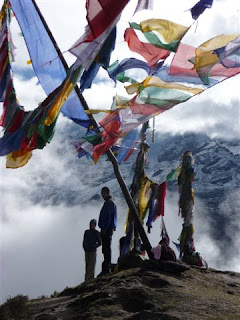

The second day was a steep climb to the next hut at Dzongri (3600 m) and we arrived in a cloudy drizzle. We set up our camp inside the very basic hut, in a room with broken windows and a wood floor, and tried to dry our wet clothes by the caretaker’s fire.

Dzongri is famous for mountain views and the sun rises at 4:30 am but by 6 am the clouds move in and completely obliterate the view. We were rewarded for 20 minutes following a short scramble up a nearby hill with stunning views of the Kanchenjanga massif. The rest of the third day we made our way to a beautiful valley called Lamunie at the base of the glacial moraine which defines Goecha-La pass. The valley is surrounded by massive, glacier-covered, sharp, scary beautiful peaks, but you would never know it walking during the day through thick clouds. We heard ice falls as we were walking in, though, so we knew there were some big mountains nearby and at night, before dusk,
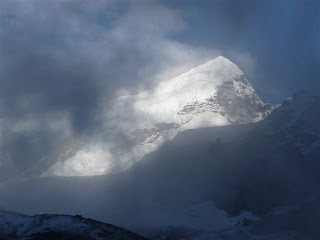
we glimpsed 2 of the peaks: Joponu and Pandim clouds flew by, showing us the icy, jagged peaks where the wind was whipping snow off the surface. A cheeky horse grazing near by ate a loaf of our bread and some apples from our food stock that had been left in the brick lean-to kitchen that has been set up at the sight, but we made dinner and settled in for sleep early, as we would be waking up early to summit.
We woke up at 2:30 am to bright moonlight and mountains staring down at us and, after waking up our guide, we headed up to Goecha-La pass. As night turned to dawn we watched the colors change over the quiet, stark landscape of a glacial moraine and lake and the surrounding peaks.


The sun came up and turned the tops of the mountains a beautiful gold and we reached Goecha-La pass at 5 am, signified by prayer flags and rock pile shrines, with about 20 minutes to stare and marvel at the awesomeness of these huge mountains: Kanchenjanga, standing another 12,000 feet above us (we were already at 16,000 feet). A huge bank of clouds moved in and we hiked down but got a second chance with about 2 hours of bright sun and clear views as we ate breakfast and broke camp—it was definitely the clearest morning of our entire time in the north of India and it was amazing. We even saw an avalanche on one of the peaks behind our camp. That day was a big one and we covered 40 km by the time it was all said and done, getting ourselves back down to Tshoka, the first hut, so that we could make it back to Yuksom the next day. We celebrated with thongbas and hung out with the caretaker of the hut and his family.
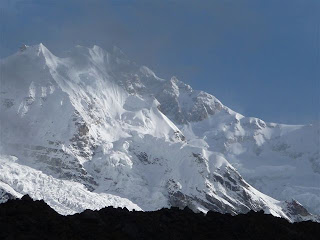
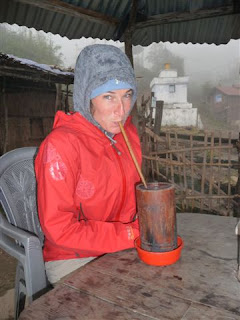
The final day of the trek got us back to Yuksom where our celebratory meal was, unfortunately, local food and not a meat-filled meal to quench our protein-deprived states. We hung around the village, visiting some of the temples and shrines and talking to other travelers over dinner and beers.

Our bodies were tired but

we pushed the next day and hiked again, this time with our big backpacks (we had no yaks). We decided to visit Kachepari Lake, a sacred lake for Buddhists about 10 miles from Yuksom, reachable by a hike that takes you very steeply down and then very steeply up again, after crossing a river.

The gods and our aching legs wanted us to chill out and we were dumped on by heavy rain during the hike. We got lost and bushwacked for awhile and by the time we reached our destination, soaked and muddy and exhausted, we were further rewarded by finding leeches all over our feet and ankles. The little things are tiny before they find you but once they latch on and start sucking blood they grow as big as a finger and when they come off, the bleeding is heavy and does not stop! Guy got destroyed and pretty much ruined a pair of shoes by bleeding, but we were greeted by our host Sonam at the guesthouse where we stayed, who took amazing care of us. We spent 2 days living with his family, playing with his 2 kids, eating delicious Nepali food, reading, sleeping (admittedly on very thin, uncomfortable mattresses) and getting enveloped in their mellow, simple, loving community. The Buddhist village above this holy lake is tiny and pretty untouched by the outside world and we watched the little boy monks walk to school at the monastery, the cows being milked, the gardens being harvested, and the children rough housing in the grass.

The lake itself has been turned into a sort of Hindu shrine and many Indian tourists come to pray or do puja or make an offering, despite the fact that it is a Buddhist place. The more we see, the less we understand about any of these religions, but it is very clear that the boundary between Hindu and Buddhist, at least, is very hazy and they are quite fluid with each other.
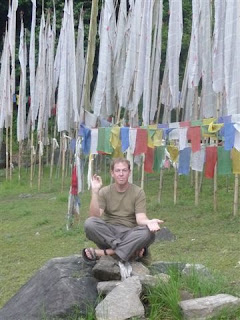
We had to leave Kachepari lake after 2 days and made our way back to Darjeeling by jeeps packed to the gills and careening over cliffs on windy roads in the fog, always reassuring. We spent one more day in Darjeeling, doing laundry and walking about. As we left we heard rumors about another strike that was to happen 2 days after we left, but we got out of town without incident and caught a train that would take us to Varanasi, the holy city on the Ganges—back to the heat, noise, in-your-face frewnzy of India!
For more pictures of
Sikkim and Yuksom click hereFor more pictures of
Goecha-La and Kanchenjunga peak click hereFor more pictures of
Kachepari Lake click here
No comments:
Post a Comment